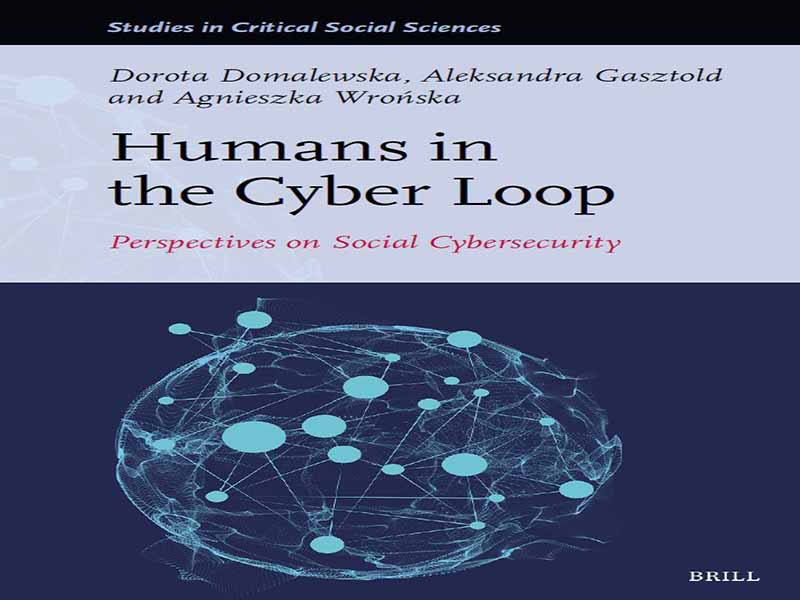- عنوان کتاب: Humans in the Cyber Loop -Perspectives on Social Cybersecurity
- نویسنده: Dorota Domalewska, Aleksandra Gasztold
- حوزه: امنیت سایبری
- سال انتشار: 2025
- تعداد صفحه: 294
- زبان اصلی: انگلیسی
- نوع فایل: pdf
- حجم فایل: 7.97 مگابایت
اینترنت و فناوریهای وب ۲.۰ میلیاردها دستگاه و کاربر را در سراسر جهان به هم متصل کردهاند. پیشرفتهای فناوری پیشرفته، یک اکوسیستم دیجیتال پیچیده و پویا ایجاد کردهاند که فعالیت انسانی در فضای مجازی را به طور قابل توجهی افزایش داده است. بسیاری از آسیبپذیریها و تهدیدهای سنتی نیز به دنیای دیجیتال مهاجرت کردهاند، جایی که تشدید شدهاند و اکنون خطرات قابل توجهی را برای افراد و جامعه ایجاد میکنند. تاکتیکهای سنتی، مانند مهندسی اجتماعی، اکنون میتوانند به طور مؤثر در مقیاس وسیع و با کارایی بسیار بیشتر اجرا شوند. به طور مشابه، اطلاعات نادرست ساختگی و دستکاری شده را میتوان به راحتی ایجاد و منتشر کرد تا بر ادراک عمومی تأثیر بگذارد و مزایای رقابتی کسب کند. اکنون میتوان از طریق الگوریتمهای پیچیده و تجزیه و تحلیل کلان داده، اقدامات فریبنده را دقیقاً به سمت افراد آسیبپذیر هدف قرار داد. دامنه و سرعت تحولات اجتماعی-فناورانه مداوم، به ویژه با پیشرفتهای سریع در هوش مصنوعی، بسیار زیاد است. علاوه بر این، درگیریهای مسلحانه مداوم نشان دادهاند که عملیات سایبری بخش جداییناپذیر جنگهای متعارف هستند. ابزارهای سایبری مخرب به طور فزایندهای در زمینه رقابت قدرتهای بزرگ مورد استفاده قرار میگیرند. در نتیجه، چالشهای امنیت سایبری بسیار فراتر از حوزه فنی محافظت از سیستمها و دادهها گسترش یافتهاند. چالشهای سایبری امروزی اکنون ابعاد اجتماعی، اقتصادی و سیاسی گستردهتری را در بر میگیرند. تهدیدات امنیت سایبری پیامدهای اجتماعی گستردهای دارند که نه تنها کاربران انفرادی، بلکه کل جوامع و جوامع را نیز تحت تأثیر قرار میدهند. از نظر اقتصادی، جرایم سایبری منجر به خسارات مالی قابل توجهی میشود. از نظر سیاسی، فعالیتهایی مانند حملات سایبری تحت حمایت دولت و کمپینهای انتشار اطلاعات نادرست، فرآیندهای دموکراتیک را تضعیف میکنند، تنشهای جهانی را افزایش میدهند و به قطبی شدن و رادیکال شدن کمک میکنند. از نظر اجتماعی، تکثیر محتوای مخرب، مانند مطالب افراطی و اطلاعات نادرست، شکافهای اجتماعی را عمیقتر و انسجام اجتماعی را تضعیف میکند. علاوه بر این، اثرات عاطفی و روانی قرار گرفتن در معرض محتوای مضر مانند نفرت و پورنوگرافی سایبری، میتواند آسیبهای ماندگاری به سلامت روان وارد کند. تروریسم سایبری و جرایم سایبری نه تنها مسائل جنایی هستند، بلکه نگرانیهای مهم امنیت ملی نیز هستند که ممکن است تنشهای اجتماعی و سیاسی را تشدید کنند. آنها تأثیر عمیق امنیت سایبری بر رفاه فردی، ثبات اجتماعی و امنیت ملی را نشان میدهند. رویکرد انسان محور، ماهیت پیچیده تهدیدات سایبری و پیامدهای گسترده آنها را به رسمیت میشناسد. همچنین نیاز به یک رویکرد چند رشتهای به امنیت سایبری را که بینشهای زمینههای مختلف را برای درک و پرداختن به عوامل انسانی در امنیت سایبری ادغام میکند، تشخیص میدهد. همزمان با تکامل فضای مجازی، درک و مدیریت ما از امنیت سایبری نیز باید ارتقا یابد تا نه تنها از سیستمها و شبکهها، بلکه از افراد و جامعه نیز به طور کافی محافظت شود. گسترش چالشها منجر به ظهور حوزه امنیت سایبری اجتماعی شده است که به تلاقی حیاتی رفتار انسان، تعاملات اجتماعی و امنیت دیجیتال میپردازد. در روزهای اولیه، امنیت سایبری در درجه اول مربوط به دفاع فنی در برابر نرمافزارهای مخرب، دسترسی غیرمجاز و نقض دادهها بود. ابزارها و تکنیکهایی مانند فایروالها، نرمافزارهای آنتیویروس، رمزگذاری و سیستمهای تشخیص نفوذ برای محافظت از رایانههای شخصی و زیرساختهای شبکه توسعه داده شدند. با این حال، امنیت سایبری اجتماعی اذعان میکند که اقدامات و آسیبپذیریهای انسانی در امنیت محیطهای دیجیتال نقش اساسی دارند. این رویکرد تمرکز را از صرفاً محافظت از زیرساختهای فناوری به درک و کاهش خطرات مرتبط با رفتار انسان در فضای مجازی تغییر میدهد. انسانها دیگر به عنوان کاربران غیرفعال دیده نمیشوند، بلکه به عنوان شرکتکنندگان فعالی دیده میشوند که به طور فعال اکوسیستم دیجیتال را شکل میدهند و به محافظت نیاز دارند.
The internet and Web 2.0 technologies have connected billions of devices and users worldwide. High-tech advancements have created a complex and dynamic digital ecosystem that has significantly increased human activity in cyberspace. Many traditional vulnerabilities and threats have also migrated to the digital world, where they have intensified and now pose significant risks
to individuals and society. Traditional tactics, such as social engineering, can now be effectively executed on a massive scale with far greater efficiency. Similarly, fabricated and manipulated disinformation can be easily created and disseminated to influence public perception and gain competitive advantages. Deceptive practices can now be precisely targeted at vulnerable individuals through sophisticated algorithms and big data analytics. The scope and pace of ongoing socio-technological developments are enormous, especially with the rapid advancements in artificial intelligence. What is more, ongoing armed conflicts have been demonstrating that cyber operations are integral to conventional warfare. Disruptive cyber tools are increasingly being used in the context of great power rivalry. Consequently, cybersecurity challenges have expanded far beyond the technical domain of protecting systems and data. Present-day cyber challenges now encompass broader social, economic and political dimensions.
Cybersecurity threats have wide-reaching social implications that not only affect individual users but also entire communities and societies. Economically, cybercrime results in significant financial losses. Politically, activities such as state-sponsored cyber attacks and disinformation campaigns undermine democratic processes, increase global tensions and contribute to polarization and radicalization. Socially, the proliferation of malicious content, such as extremist material and disinformation, deepens societal divisions and weakens social cohesion. Additionally, the emotional and psychological effects of exposure to harmful content such as hate and cyber pornography, can cause lasting damage to mental health. Cyber terrorism and cybercrime are not only criminal issues but also significant national security concerns that may escalate social and political tensions. They demonstrate the profound impact of cybersecurity on individual well-being, societal stability and national security. The human-centered approach recognizes the complex nature of cyber threats and their broad implications. It also recognizes the need for a multidisciplinary approach to cybersecurity that integrates insights from various fields to understand and address human factors in cybersecurity. As cyberspace continues to evolve, so must our understanding and managing of cybersecurity to ensure adequate protection not only of systems and networks but also of people and society. The expansion of challenges has given rise to the field of social cybersecurity, which addresses the critical intersection of human behavior, social interactions and digital security. In its early days, cybersecurity was primarily concerned with technical defenses against malicious software, unauthorized access and data breaches. Tools and techniques such as firewalls, antivirus software, encryption, and intrusion detection systems were developed to protect individual computers and network infrastructures. Social cybersecurity, however, recognizes that human actions and vulnerabilities are central to the security of digital environments. It shifts the focus from merely protecting technological infrastructures to understanding and mitigating the risks associated with human behavior in cyberspace. Humans are no longer viewed as passive users but as active participants who actively shape the digital ecosystem and who need protection.
این کتاب را میتوانید از لینک زیر بصورت رایگان دانلود کنید:
Download: Humans in the Cyber Loop




































نظرات کاربران